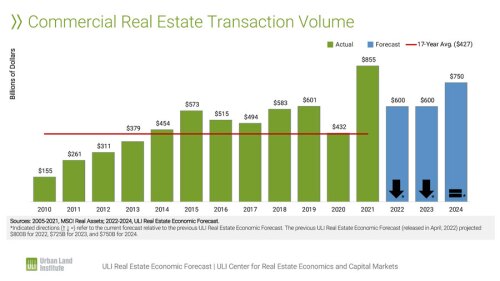
From left to right: Taylor Mammen, chief executive officer of RCLCO Fund Advisors for RCLCO in Los Angeles; Mary Ludgin, senior managing director and director of global investment research for Heitman in Chicago; Lee Menifee, managing director at PGIM Real Estate in Los Angeles; and moderator Suzanne Mulvee, senior vice president of research and strategy for GID in Boston, discussing the latest ULI Real Estate Economic Forecast at the 2023 ULI Spring Meeting in Toronto.
At the “Real Estate Economic Forecast in Real Time: Experts Share Their Expectations for ’23, ’24, and ’25” panel at the recent 2023 ULI Spring Meeting in Toronto, moderator Suzanne Mulvee asked industry experts to react to the recently released semiannual ULI Real Estate Economic Forecast.
Mulvee, who is senior vice president of research and strategy for GID in Boston, started by noting that the forecast expects employment growth to increase by about 1.5 million this year and by about 800,000 next year.
“I look at these numbers and I don’t see a recession,” she said. “The unemployment rate, however, is expected to go up to about 4.6 percent by 2024, which suggests job losses of something close to 1.5 million. The Consumer Price Index inflation rate is forecast to be above 4 percent by the end of 2023. My first take is that this is an optimistic real estate forecast. Is it too optimistic?”
“This survey is much more optimistic than I am,” said Lee Menifee, managing director at PGIM Real Estate in Los Angeles. “I think it’s smart for the industry to plan for a relatively full-employment recession and think about how that will reverberate through property markets differently than in the last big downturn. Also, on the capital market side, these numbers suggest that relief is coming very soon, and I’m not sure that we’re actually seeing that now.”
“It is looking as if, if we are going to experience a recession, it will be delayed,” said Taylor Mammen, chief executive officer of RCLCO Fund Advisors for RCLCO in Los Angeles. “If we believe that a recession is inevitable—and the consensus seems to suggest that we do—it would be better to get it over with sooner rather than later: reset pricing, get some certainty in valuations and go-forward forecasts, so that we can get back to what we might perceive as normal.”
Mary Ludgin, senior managing director and director of global investment research for Heitman in Chicago, said that she feels more optimistic than usual going into a recession, at least about job growth.
“The Chicago Transit Authority and others who weren’t able to hire during the height of COVID are finally able to hire, and they are going to hold onto those people,” she said. “That said, I don’t know what elements are going to pull us out of recession. I don’t believe that the divided U.S. House and Senate are going to allow for much in the way of a fiscal stimulus.”
The recent banking crisis, starting with the collapse of Silicon Valley Bank, also concerned the panelists.
“The risks of credit contagion in the economy—and especially for real estate—are really high,” Menifee said. “Credit has been getting tighter for a year, the lagged impact of the rate increases has been slowly filtering in, and there will be more failed banks and isolated credit events.”
“All economists and prognosticators are looking for other factors that might lead to credit contagion,” Mammen said. “Many of them are looking at commercial real estate, but our view is that commercial real estate likely isn’t a contagion factor for the broader economy. There will be some pain for certain lenders, but it doesn’t seem to be large enough to play the role that mortgage-backed securities played in the great financial crisis of 2008.”
Some $200 billion worth of office loans will mature this year, however, as Ludgin pointed out.
“Most of that is CMBS [commercial mortgage–backed securities], so it’s going to be hard for those who rely on CMBS in a big way—the regional mall owners and office owners.”
Transaction volumes in the market have dropped significantly with the slowing of commercial real estate lending.
“It shows how active the banks and particularly the regional lenders were in this space,” Mulvee says. “They’re leaving a pretty big void, and that’s going to impact commercial real estate transaction volume for a while.”
“If we see something that would rapidly lead to lower valuations, that would free up the market quite a bit,” Mammen said. “Right now, there’s a big difference between how assets are valued within institutions and how they would trade. We always go through this whenever there’s a change in a dynamic or regime. It usually takes a while for that gap to narrow.”
Ludgin noted that appraisers have recently found market-clearing prices for office buildings in San Francisco, Los Angeles, and Chicago.
“The appraisers are going to be moving in a way that they haven’t,” she said. “I’ll quote an appraiser I saw at an NCREIF meeting recently. He said that if you put your asset to market and it didn’t trade, you should write it down, which is not what appraisers have done historically. They’re trying to move things through faster.”




